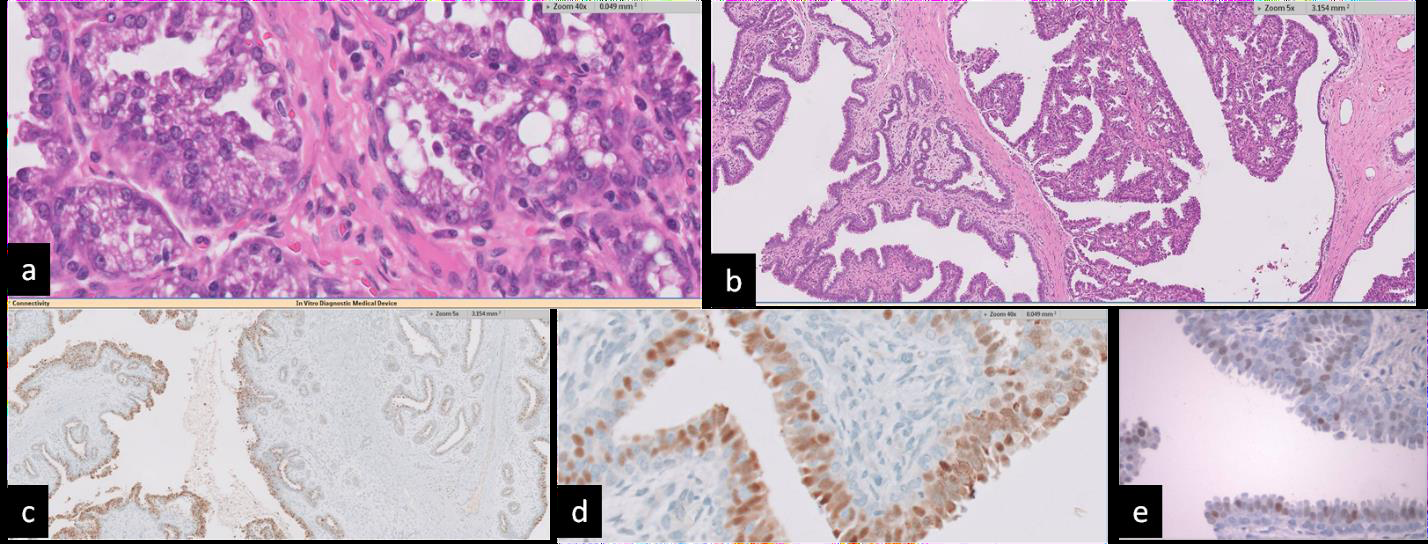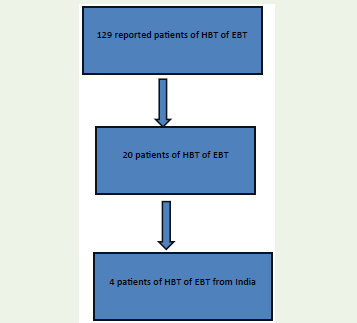Case report
A Rare Case of Solitary Unilateral Ectopic Breast Tissue in Vulva Region in a Young Female Patient: Case Report of Youngest Female Patient from Indian Subcontinent and Case Series Analysis
Sodhi B1* and Punj J2
1Department of Pathology, Apollo Cancer Centre, Chennai, India, Presently in Delhi, Working at Max Super Specialty Hospital
2Department of Anesthesiology, All India Institute of Medical Sciences, NewDelhi, India
2Department of Anesthesiology, All India Institute of Medical Sciences, NewDelhi, India
*Corresponding author:Babita Sodhi, Department of Pathology, Apollo Cancer Centre, Chennai, India, Presently in Delhi, Working at Max Super Specialty Hospital, India, E-mail Id: babitasodhi196@gmail.com
Article Information:Submission: 04/09/2024; Accepted: 27/09/2024; Published: 30/09/2024
Copyright: © 2024Sodhi B, et al. This is an open access article distributed under the Creative Commons Attribution License, which permits unrestricted use, distribution, and reproduction in any medium, provided the original work is properly cited.
Abstract
Ectopic Breast tissue (EBT) is a rare entity. It occurs due to the incomplete regression of the milk line which extends from axilla to groin and occurs commonest in axilla and rarest in vulva.EBT has the potential to turn malignant, thus the condition needs to be followed up including cytology if required. However, rarity of the condition frequently delays the diagnosis which can lead to morbidity and mortality in a patient. There is urgency of formulation of
guidelines for management of such patients which should be addressed.
We report the youngest patient of healthy EBT from the Indian subcontinent in a 25-year-old woman and discuss review of literature.
We report the youngest patient of healthy EBT from the Indian subcontinent in a 25-year-old woman and discuss review of literature.
Keywords:Ectopic Breast Tissue; Vulva; Estrogen Receptor; Progesterone Receptor; Immuno histochemistry
Introduction
Ectopic breast tissue (EBT) is a rare entity with an incidence of
2-6% in women &1-3% in men, with women to men ratio of 2:1 [1]. It
is a developmental anomaly due to incomplete regression of milk line
and presents as residual breast tissue with or without nipple areolar
complex in milk ridge line in addition to normal pectoral tissue.
It can be solitary or multiple [2,3]. EBT in vulva, including benign
and malignant pathology, are reported in literature in 129 patients
in age group of 18-89 years [4], of which20 patients with healthy
breast tissue in EBT is reported from 29-69 years. From the Indian
subcontinent only 4 such patients are reported in women from 28-60
years. [5-8]. We report the youngest female patient of 25 years old of
healthy breast tissue (HBT) in EBT from the Indian subcontinent and
discuss review of literature, management dilemmas and urgency to
formulate guidelines in such patients.
Case History
A 25-year-old pregnant lady reported with non-painful swelling
on left side of vulva at eight month of gestation which progressively
increased after delivery. A soft mobile mass of 3x2x1cm was palpated
in the vulva. Excisional biopsy was done under local anesthesia.
Cut surface revealed grey white and lobulated mass. Differential
diagnosis of lipoma, Bartholin Cyst, and Hidradenitis Papilliferum
was made. On histologic evaluation on staining with hematoxylin
and eosin, lobules of healthy breast tissue with lactational changes
were seen. Immunohistochemistry revealed estrogen receptor (ER)
positive (ALL RED Score 8) (Figure 2 c-d) and focally positive for
progesterone receptor (PR) (Figure 2e). [9] Diagnosis of EBT (Figure
2a) (Figure 2b) was made.
Discussion
The present patient is the youngest reported patient (25 years)
Figure 1:Ectopic Breast tissue resembling Normal Breast tissue
(Source: Benign Cysts, Rests, and Adnexal Tumors of the Vulva. In:
Crum Christopher P, Nucci Marisa R, Lee Kenneth R, editors. Diagnostic
gynaecologic and obstetric pathology, 2nd ed. Philadelphia: Elsevier
Saunders; 2011. p. 89.
Figure 2:Histopathological analysis of present patient
(a & b) Ectopic breast with Adenosis, Epitheliosis and Lactational Changes
(a) (H and E 5X), (b) (H and E 40X). (c & d) Estrogen Receptor Showing diffuse and intense positivity (ALL RED
Score 8) (c) (IHC 5X), (d)(IHC 40X).(e) Progesterone Receptor showing focal positivity (IHC 40x)
Figure 3:PRISMA representation of systemic review of HBT of EBT
HBT: Healthy Breast Tissue; EBT: Ectopic Breast Tissue
old) of HBT of EBT in vulva from the Indian subcontinent. Previous
literature reveals 126 patients of EBT of which HBT of EBT was
reported in 20 patients in the age group from 29-69 years including, 4
such patients in age group of 28-60 years from the Indian subcontinent
are reported. [4-8].
Primary milk line develops in human embryo at 6 week gestation
and extends from axilla, through thoracic (pectoral, chest area),
abdominal, inguinal, to pubic area, where it traverses bilaterally
and atrophies by 9 wks of gestation except in chest where normal
breast tissue develops. Incomplete regression of primary milk line
gives rise to EBT anywhere in milk line and appears as smooth well
circumscribed mass with/ without nipple and /or areola. EBT may
not be clinically apparent unless it becomes site of pathological
process or physiological changes. The commonest site of EBT is
axilla, however it is reported in unusual sites like vulva, chest, face,
ear, abdomen, inguinal region, perineum, perianal region, heart and
foot.EBT on vulva is rarely reported and may present as an abscess,
bartholin abscess, fibroadenoma, recurrent vulval Fibroadenoma,
phyllodes tumors and atypical hyperplasia [10-16]. EBT in vagina
was reported at a rare site of median episiotomy [17]. Extra vulval
EBT was reported in infraclavicular chest wall, in perineal region of
a gentleman,in inguinal region and as an enlarging abdominal mass
[18-21]. Usually EBT occurs without nipple and/or nipple areolar
complex. However, EBT with nipple areola in vulva with lactation
from vulva and perianal mass is also reported including Indian
subcontinent [22,23].
Lactational changes in EBT vulva& lactational adenoma of EBT
have also been documented in literature [24,25]. Rarely, EBT may
present outside ventrally placed milk ridge such as on the face or
foot which can be explained by displacement or migration of milk
ridge anlage [26]. Heterotopic breast type epithelial inclusion was
seen in atrial tissue in surgically explanted native heart of 72-year-old
transplant recipient [27]. EBT occurs commonly in reproductive age
group, however rarely it’s reported in postmenopausal women [28].
The youngest reported patient of HBT of EBT of vulva was reported
in an adolescent girl of 18 years [29]. In literature HBT in EBT vulva
has been reported in 20 patients with 4 from Indian subcontinent [30-45]. The management of EBT is similar to a growth seen in healthy breast. Previously, patients of EBT which revealed fibroadenoma and
HBT, local excision of EBT was done. [2, 3,5,7,8,30-43] [Table 1] as
in the present patient. If EBT reveals carcinoma, then according to
the stage of carcinoma, neoadjuvant chemotherapy maybe added.In
a patient of EBT in infraclavicular area, cytology revealed invasive
ductcarcinoma and patient was treated with chemotherapy and
hormone therapy.
The differential diagnosis of EBT is lactational breast,
Hidradenoma papilliferumor Bartholin Cyst. Lactational breast is
diagnosed by Immunohistochemical (IHC) demonstration of ER
and PRas in the present patient. Hidradenoma papilliferum is a
well circumscribed mass lesion with papillary glandular epithelium
with associated myoepithelial cells and a fibrovascular core forming
true papillae. Bartholin cyst show epithelial lining as squamous,
transitional or mucinous.
EBT is under same hormonal influences as normal breast and
undergoes same physiological and pathological changes as of normal
breast and thus may transform to malignant variant. Most cases
of EBT are benign however few malignant cases of EBT are also
reported which includes papillomas, intraductal carcinoma, invasive
ductalcarcinoma, metachronous vulval EBT adenocarcinoma,
invasive lobular carcinoma and mucinous Adenocarcinoma [46-51].
Primary carcinoma should be differentiated from metastatic breast
carcinoma by initial diagnosis by fine needle aspiration cytology and
confirmation by histopathological examination [52,53]. Benign EBT
may convert to malignant morphology.
The entity of HBT presenting as EBT in vulva is rare. However,
it may convert to malignant variant anytime during the course of
the lifespan of the patient. Thus, it is recommended that a treating
physician on encountering any mass in vulva should bevigilant in
its diagnosis including cytology and regular follow ups to rule out
malignancy. The mass maybe removed if the patient desires so due
to discomfort or cosmetic reasons as in the present patient. There
are no guidelines in literature on management of HBT in EBT vulva
and thus requires urgency to formulate guidelines on screening and
follow up of EBT.
Conclusion
EBT should be suspected in any subcutaneous mass along milk
line and should be regularly followed up due to its malignant potential.
Due to scarcity of such patients in reported literature, every case of
EBT should be reported and documented to formulate guidelines.




